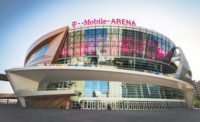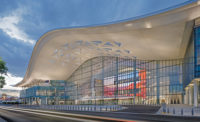T-Mobile Arena
Las Vegas
Best Project
Owner/Developer AEG and MGM Resorts International
Owner’s Representative ICON Venue Group
General Contractor Hunt/PENTA, a Joint Venture
Lead Design Firm Populous
Structural Engineer Thornton Tomasetti
Civil Engineer Lochsa Engineering
MEP Engineer M-E Engineers Inc.
Subcontractors Corwin Corr; Daktronics; KONE; Mojave Electric; Quality Mechanical Contractors; SME; Raymond; Thor Construction
T-Mobile Arena, which is owned by AEG and MGM Resorts, opened on April 6 after nearly two years of construction. The $375-million venue hosts sports events, concerts, award shows and other types of entertainment. Located on a 16-acre parcel, the 650,000-sq-ft arena can seat up to 20,000.
The arena is designed to achieve LEED Gold certification and includes ADA accessibility at all levels. Features include 44 luxury suites, premium balconies with views of the plaza, a park and two-dozen private boxes.
Teams utilized more than 7,000 pieces of steel, weighing more than 7,100 tons in total. Meanwhile, the 350-ft-long main trusses support a 200,000-lb, capacity-rigging grid, which is used for hanging equipment for concerts and events.
At two ends of the site, the underground presence of power and fiber-optic cables for several resorts, casinos and other businesses complicated pier installation. Preconstruction testing also revealed extensive caliche.
“There were a lot of buried treasures,” says Mitch Bernard, project manager at Hunt-Penta.
Inside the arena, northeast and southeast balcony lounge areas extend over the upper bowl. A single column helps to support the balcony and the tips of the triangle nearly reach the upper bowl’s inboard edge.
Design, ownership, management and construction teams reduced the building schedule to 19 months from 22. Teams clocked more than 2 million work hours with zero lost-time injuries, impressing the safety judges. Safety policies included using crane consultants, requiring safety discussions before the start of every shift and requiring subcontractors to employ full-time safety coordinators.
“Anytime you put a crane boom in the air, that in itself says you better pay attention. But at the same time, every time you lift a miter saw it is dangerous too,” says Monte Thurmond, vice president at Hunt.
All employees on the project were tested for drugs and trained in an extensive safety orientation led by the Hunt/PENTA safety manager before beginning work. Additionally, all personnel and contractors began the workday with a safety huddle and stretch and flex activities where pretask plans were discussed for the day’s activities.
Thurmond says complete buy-in and teamwork were responsible for safety results that include an OSHA recordable incident rate of 2.5.
“What we had was a team of people,” Thurmond says. “It began with ownership and merged with the cultures of Hunt and Penta and the cultures of the subcontracting companies that we engaged. We had complete buy-in from every participating party that safety was going to be the most important thing for the project.”







Post a comment to this article
Report Abusive Comment